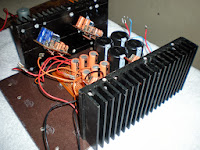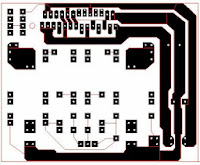Well, in bits and pieces i had 3-way filter and LM4780 modules, but i always wanted to make a compact and high power amplifier system. Progress is ON! and just the integration of modules is remaining... Check out the pics -->
3-way filter will also come inside. Front will be glass panel. And inputs will come at right front glass panel and the heatsink.
Power Supply is in seperate enclosure. Regulated to 30 V using a pair of LT1083 (free samples :) ). I plan to put a higher VA Transformer later.
Jul 27, 2008
3 Way Active CrossOver.
I made 3-way active crossover circuit based on a project published in 'Electronics World', it was basically a 3-way subtractive cross-over. Its online version can be found at - 3-way subtractive X-over.

I made its PCB but when i run it, to my dissappointment, the output signal level was quite Low. Meantime i compared a subtractive crossover design as compared to a 24th order Linkwitz-Riley X-over, i decided to make a new filter based on Linkwitz-Riley design by Rob Elliot Project 09.
Its PCB is ready, just a little soldering is pending. Very eager to see it sing.
Make@home PCB drill.
A simple PCB drill can be made using taperecorder motor. The shaft of an old motor can be grinded using a file to form a drill bit as shown in figure. Shaft has to be grinded to form this shape.
The tool point may need sharpning after drilling a number of holes. And it produces a decent quality hole. The dia of holes very much depends upon the dia of tool, which can be adjusted by repeat grinding.
Using a small ball-point pen refill as coupling, join the motor and this drill bit. And ur portable PCB drill is ready.
The tool point may need sharpning after drilling a number of holes. And it produces a decent quality hole. The dia of holes very much depends upon the dia of tool, which can be adjusted by repeat grinding.
Jul 22, 2008
Making Gainclone PCB at Home.
Since single unit of gainclone amplifier is quite small, its quite easy to build its PCB by Laser toner transfer method. I myself had made around 15-20 PCBs for Lm3886, 4780 and for filters.
A lot of material is available online for making PCBs, so i won't go in details but like to share on certain things I found from experiance:-
1. Laser Printer should be used at Best Quality mode at Bond paper setting.
2. Cut the Copper board (blank PCB) to correct size of desired PCB.
3. Get the laser print on transparency sheet or a Glossy paper and put the sheet on copper board, Ensure that transparency sheet should be bigger than the copper board around 2 cms from all sides. (This is a key point in getting un-distorted track transfer on copper board).
4. Keep 5 layers of newspaper on a flat board, put copper board, put the transpancy sheet, again keep 5 sheets of newspaper. Put hot clothes iron (full temp) on top with a little pressure for 2 minutes+ . (some smoke may come from newspaper,don't worry)
5. Let it cool for a minute and then peel off the transparency sheet slowly from board. The tracks may break at some points as the toner never always get stick fully to copper plate. Use a fine permanent marker to complete the broken tracks. The permanent marker usually stays if the etching time is not too long, so use a strong etching solution.
A lot of material is available online for making PCBs, so i won't go in details but like to share on certain things I found from experiance:-
1. Laser Printer should be used at Best Quality mode at Bond paper setting.
2. Cut the Copper board (blank PCB) to correct size of desired PCB.
3. Get the laser print on transparency sheet or a Glossy paper and put the sheet on copper board, Ensure that transparency sheet should be bigger than the copper board around 2 cms from all sides. (This is a key point in getting un-distorted track transfer on copper board).
4. Keep 5 layers of newspaper on a flat board, put copper board, put the transpancy sheet, again keep 5 sheets of newspaper. Put hot clothes iron (full temp) on top with a little pressure for 2 minutes+ . (some smoke may come from newspaper,don't worry)
5. Let it cool for a minute and then peel off the transparency sheet slowly from board. The tracks may break at some points as the toner never always get stick fully to copper plate. Use a fine permanent marker to complete the broken tracks. The permanent marker usually stays if the etching time is not too long, so use a strong etching solution.
Subwoofer Filter
I made a subwoofer filter as per the design discussed in Rob Elliot DIY Audio Site - Active Sub-Woofer and Controller, Project 48.

The circuit is working very well with my Subwoofer setup. I am running at on LM4780 parallel amplifier.
Rob Elliot has come up with a revision of the circuit.

The circuit is working very well with my Subwoofer setup. I am running at on LM4780 parallel amplifier.
Rob Elliot has come up with a revision of the circuit.
Jul 21, 2008
Various types of Gainclone circuits...
 1. Basic Non-Inverting circuit.
1. Basic Non-Inverting circuit.Input signal is fed into the non-inverting input of the Audio Chip. It is the most basic and popularly used configuration.
Ref: LM3886 Datasheet.
2. Inverting configuration.
Input signal is fed into the Inverting input of the Audio Chip. It is not commonly used, but audio enthusiasts who had made circuits in this configuration had reported better audio quality in terms of clarity and headroom. It also uses less number of components.
Ref: LM4780 product Datasheet.
Input signal is fed into the Inverting input of the Audio Chip. It is not commonly used, but audio enthusiasts who had made circuits in this configuration had reported better audio quality in terms of clarity and headroom. It also uses less number of components.
Ref: LM4780 product Datasheet.

3. Advanced Non-inverting circuit.
A few additional components are added in the basic circuit to form advanced circuit. Additional components are added to improve certain characteristics like stability, immunity to oscillations and erratic behaviors of Audio Chip.
Additional components – RIN, CIN, RB, Cf, Rf2
Ref: LM4780 product Datasheet.
A few additional components are added in the basic circuit to form advanced circuit. Additional components are added to improve certain characteristics like stability, immunity to oscillations and erratic behaviors of Audio Chip.
Additional components – RIN, CIN, RB, Cf, Rf2
Ref: LM4780 product Datasheet.

4. Parallel and Bridged circuits.
Gainclones are highly flexible ICs. They can be connected in Bridged configuration (BA), Parallel configuration (PA) and in hybrid bridged-parallel configurations (BPA). Configurations can be decided based on Drive voltage and Load Impedance.
Ref: Design note by NS. An1192
External Links for PA & BPA designs:- BPA300 Gainclone, PA100 Gainclone
5. Special circuits.
Audiophiles who understand true potential of Gainclones Chips had harnessed their untapped potential by making special circuits employing buffers, DC servo control and controlled feedback. Some of the circuits are:
External Links:- My "audiophile" LM3886 approach in DIYAudio
Evolution of PCB for LM4780 based amplifier.
I had designed various PCBs for LM4780 based amplifier when I received 5 samples from National Semiconductor. I could get only Single-sided copper board in my market so I created the PCB single sided only.
This is the first one. I build this from scratch. Studying the pin details of LM4780 and I draw them on paper just as the basic schematic circuit is shown.
Little tuning of the PCB for thicker Power Supply tracks.
But it had a major constraint – 6 nos of jumper wires connecting the IC. I wanted to avoid that, so I redesigned the PCB. One very good thing I came to know about from DiyAudio was the use of n/c pins. So this was the All new third version. This came out to be most compact and straight layout. I made around 10 PCBs of this one.
This one is the latest. I tried to remove 2 more jumpers from V++ supply track and further thicken the power supply tracks. Mmm, still thinking to go for another version, little spacious this time. Troubleshooting become difficult in compact PCBs.
But it had a major constraint – 6 nos of jumper wires connecting the IC. I wanted to avoid that, so I redesigned the PCB. One very good thing I came to know about from DiyAudio was the use of n/c pins. So this was the All new third version. This came out to be most compact and straight layout. I made around 10 PCBs of this one.
This one is the latest. I tried to remove 2 more jumpers from V++ supply track and further thicken the power supply tracks. Mmm, still thinking to go for another version, little spacious this time. Troubleshooting become difficult in compact PCBs.
Jul 20, 2008
GainClone ??
GainClones are quite popular with audio enthuiaists now a days. They provide cost effective and high quality solution for DIY home audio systems. A GainClone basically consists of an Audio Power Amplifier IC (most famous are LM1875 , LM3875, LM3886 & LM4780) in addition with basic discrete components like capacitors, resistors and inductors.
In this Blog I have shared my experiences during making a Gainclone amplifier of mine. And i got lot of help from other people from internet and especially DIY sites like DiyAudio and ESP Project Pages.
In this Blog I have shared my experiences during making a Gainclone amplifier of mine. And i got lot of help from other people from internet and especially DIY sites like DiyAudio and ESP Project Pages.
Subscribe to:
Comments (Atom)






























